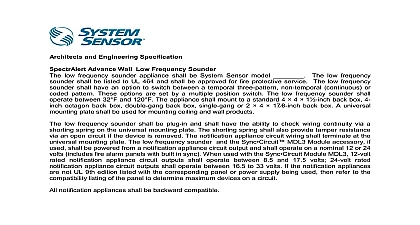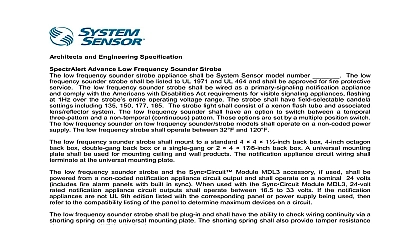System Sensor Low Frequency Notification Appliances

File Preview
Click below to download for free
Click below to download for free
File Data
| Name | system-sensor-low-frequency-notification-appliances-8570912634.pdf |
|---|---|
| Type | |
| Size | 874.18 KB |
| Downloads |
Text Preview
A P P L I C A T I O N S G U I D E Frequency Frequency 3 Evacuation Requirements 5 Effectiveness and the Development of Frequency Requirements 3 of Sleeping People a Decade of Research 3 Research on Waking Effectiveness 3 Frequency Requirements in NFPA 72 3 18 3 24 4 29 4 on NFPA 720 4 6 4 9 4 on UL Standards 4 on the International Building IBC and Fire Code IFC 5 on Occupancies 5 5 6 6 Supply Considerations 6 Applications 7 vs General Notification 7 Fire and Carbon Monoxide Systems 7 7 GUIDE LOW FREQUENCY NOTIFICATION APPLIANCESfirealarmresources com Research on Waking Effectiveness purpose of this guide is to provide information about low frequency 520 notification appliance requirements used in fire alarm and carbon mon systems It outlines the development of the NFPA 72 NFPA 720 and standard requirements It also provides an overview and guidance for and usage of low frequency notification appliances within fire and carbon monoxide systems this information is based on industry expertise it is intended to be only as a guide The requirements of applicable codes and standards well as directives of the Authorities Having Jurisdiction AHJ should be In particular following the most current versions of NFPA 72 and 720 for installation and testing of systems is key to the effectiveness low frequency notification appliances NFPA 72 Technical Committee members were concerned about the effectiveness of the standard 3 KHz alarm signal for people with loss the elderly school aged children and the alcohol impaired 2006 NFPA petitioned the Fire Protection Research Foundation FPRF carry out research studies to focus on the effectiveness of the stan fire alarm signal for certain high risk groups Working with Dr Bruck funded two studies Effectiveness of Alarms for Adults Who Hard of Hearing and Effectiveness of Alarms for the Alcohol goal of these studies was to optimize the performance requirements to the needs of these high risk groups Study participants were exposed a range of signals across two non consecutive nights while they were The six signals tested were 1 Effectiveness and the Development Low Frequency Requirements fire alarm systems and smoke alarms provide life saving value for when they are awake their greatest potential benefit may be when are asleep This is illustrated in a 2010 U S Fire Administration that reports 50 percent of fire fatalities in residential buildings occur the hours of 10 p m and 6 a m the time when most people are Further fatal fires peak between 4 a m and 5 a m 1 400 Hz square wave signal 520 Hz square wave signal Pure tone 3 KHz signal Bed shaker Pillow shaker unimpaired adults wake up quickly to the audible 3 KHz alarm signal even at levels well below 75 dBA 2 But according to the Fire Administration study 13 percent of fire fatalities in residential build are occupants less than 10 years old It is also suspected that over percent of civilian fire fatalities in residential building fires are linked to a sedative that can increase arousal thresholds drug or chemi influence we know adults wake up quickly to the audible fire signal the U S Fire Administration study results beg the follow question How effective is the signal at waking high risk of the population such as school age children occupants expe some form of chemical or alcohol impairment or people who are of Sleeping People a Decade of Research 2008 Dr Dorothy Bruck released a compilation of a decade worth research at Victoria University on the effectiveness of various alarm for awakening people During this study Dr Bruck ran numerous using different types of signals to determine their waking effec for healthy adults and high risk groups all the signals tested the low frequency signal with a fundamental fre of 520 Hz was most effective at waking the majority of participants the low frequency signal was found to be 6 to 10 times more at waking people than the standard alarm signal In adults with loss it was more than 6 times as effective as the standard signal more effective than bed and pillow shakers 18 testing these signals the FPRF studies concluded The low frequency 520 Hz square wave signal is the most effective by up 92 percent of hearing impaired participants when presented or below 75 dBA for 30 seconds standard 3 KHz signal woke up 56 percent at or below 75 dBA The low frequency 520 Hz signal is superior to bed shakers and pillow at waking hearing impaired participants 2 Frequency Requirements in NFPA 72 low frequency 520 Hz requirements were fully adopted into the 2010 of NFPA 72 and subsequent editions The compliance date for the requirement was set for January 1 2014 which provided a five year for Nationally Recognized Test Laboratories NRTLs such as UL and ETL to develop test requirements for product standards This time also gave manufacturers time to develop products to comply with product standards new NFPA 72 low frequency 520 Hz requirements are found in Chapters 24 and 29 The following provides an overview for the low frequency in each of these chapters 18 covers the audible alarm signal requirements that are part of a premises fire alarm system The requirements in Chapter 18 do cover the audible alarm signal produced by a smoke alarm or a house fire alarm system 18.4.5.3 under Sleeping Area Requirements took effect on January 2014 This section establishes that the audible fire alarm signal in sleep spaces must be low frequency SENSORfirealarmresources com the 2013 edition of NFPA 72 the text was slightly modified to clarify that low frequency 520 Hz requirement is only for sleeping spaces and for purpose of awakening occupants examples of spaces covered by this requirement are hotel guest and college and university dormitory sleeping rooms Chapter 18 Committee chose to apply the requirement to all sleeping not just those where occupants have self identified as having a hear impairment This was done for the following reasons Many people are not aware they have a hearing impairment average ambient or 5 dB above maximum sound level whichever greater Duration of the signal must be at least 60 seconds NFPA 72 2013 was modified to clarify that low frequency alarm signals only required in the sleeping spaces Chapter 29 committee took a different position than Chapter 18 and to only require the low frequency signal in sleeping spaces for that are classified to have mild to severe h


